Business Environment of Tesco: Types, Structure, and Analysis - Unit 1
VerifiedAdded on 2023/01/12
|18
|3967
|82
Report
AI Summary
This report provides a detailed analysis of Tesco's business environment, examining various aspects of the organization. It begins by differentiating between for-profit, not-for-profit, and non-government organizations, followed by an exploration of legal structures such as sole traders, partnerships, and private limited companies, with specific examples. The report then delves into the size and scope of organizations, comparing micro, small, medium, and large enterprises, including their objectives, market share, and growth strategies. It further investigates the global growth and development of transnational, international, and global organizations, highlighting the differences between franchising, joint ventures, and licensing. The report also addresses industrial structures, competitive analysis, market forces, and the roles of stakeholders. It examines the interrelationships between marketing, finance, human resource management, and operations within Tesco, and how these functions align with the overall organizational mission and objectives. Finally, it discusses different organizational structures, including strategic business units, matrix, and functional levels, and their complexities within transnational, international, and global contexts.
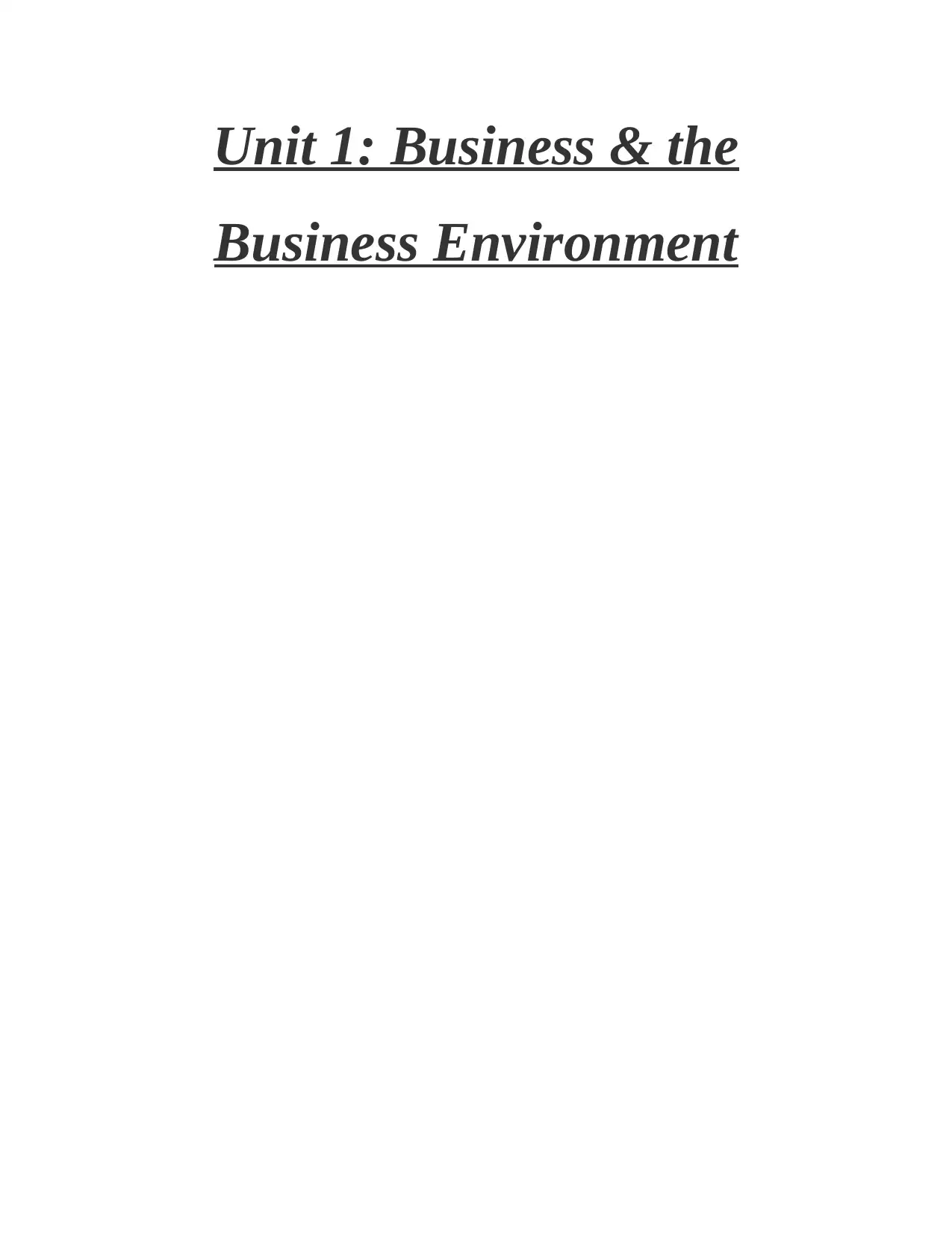
Unit 1: Business & the
Business Environment
Business Environment
Paraphrase This Document
Need a fresh take? Get an instant paraphrase of this document with our AI Paraphraser
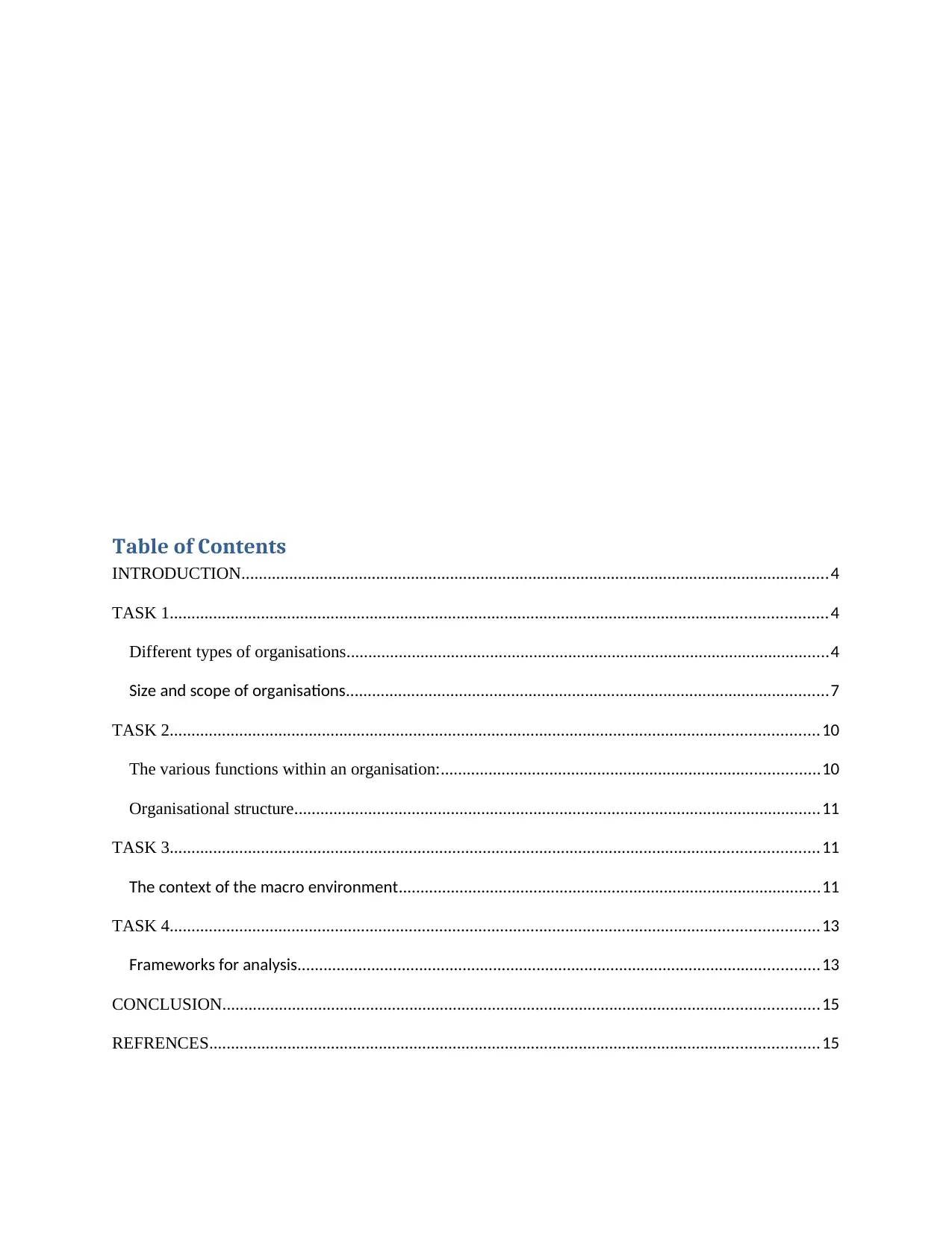
Table of Contents
INTRODUCTION.......................................................................................................................................4
TASK 1.......................................................................................................................................................4
Different types of organisations...............................................................................................................4
Size and scope of organisations...............................................................................................................7
TASK 2.....................................................................................................................................................10
The various functions within an organisation:.......................................................................................10
Organisational structure.........................................................................................................................11
TASK 3.....................................................................................................................................................11
The context of the macro environment.................................................................................................11
TASK 4.....................................................................................................................................................13
Frameworks for analysis........................................................................................................................13
CONCLUSION.........................................................................................................................................15
REFRENCES............................................................................................................................................15
INTRODUCTION.......................................................................................................................................4
TASK 1.......................................................................................................................................................4
Different types of organisations...............................................................................................................4
Size and scope of organisations...............................................................................................................7
TASK 2.....................................................................................................................................................10
The various functions within an organisation:.......................................................................................10
Organisational structure.........................................................................................................................11
TASK 3.....................................................................................................................................................11
The context of the macro environment.................................................................................................11
TASK 4.....................................................................................................................................................13
Frameworks for analysis........................................................................................................................13
CONCLUSION.........................................................................................................................................15
REFRENCES............................................................................................................................................15
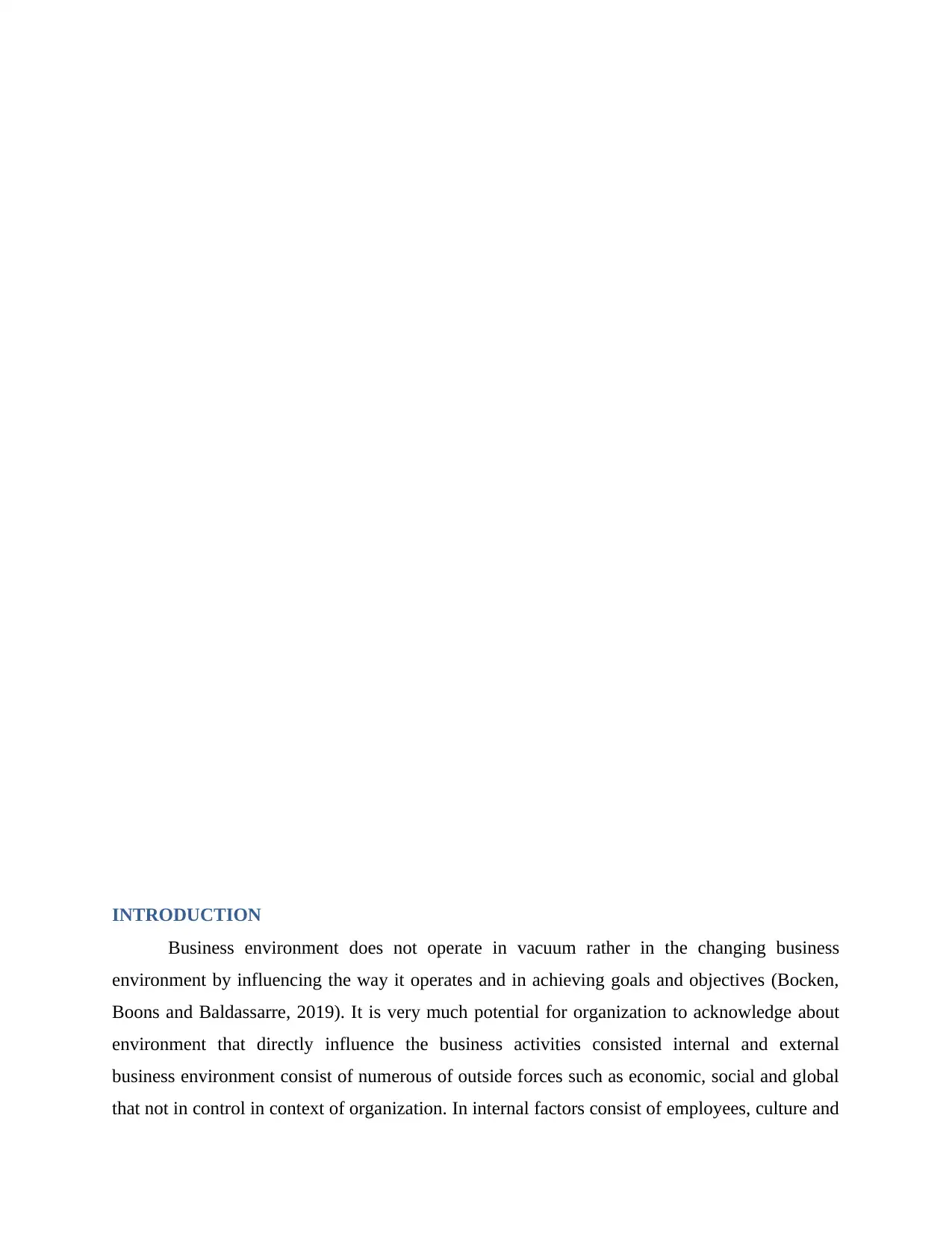
INTRODUCTION
Business environment does not operate in vacuum rather in the changing business
environment by influencing the way it operates and in achieving goals and objectives (Bocken,
Boons and Baldassarre, 2019). It is very much potential for organization to acknowledge about
environment that directly influence the business activities consisted internal and external
business environment consist of numerous of outside forces such as economic, social and global
that not in control in context of organization. In internal factors consist of employees, culture and
Business environment does not operate in vacuum rather in the changing business
environment by influencing the way it operates and in achieving goals and objectives (Bocken,
Boons and Baldassarre, 2019). It is very much potential for organization to acknowledge about
environment that directly influence the business activities consisted internal and external
business environment consist of numerous of outside forces such as economic, social and global
that not in control in context of organization. In internal factors consist of employees, culture and
⊘ This is a preview!⊘
Do you want full access?
Subscribe today to unlock all pages.

Trusted by 1+ million students worldwide
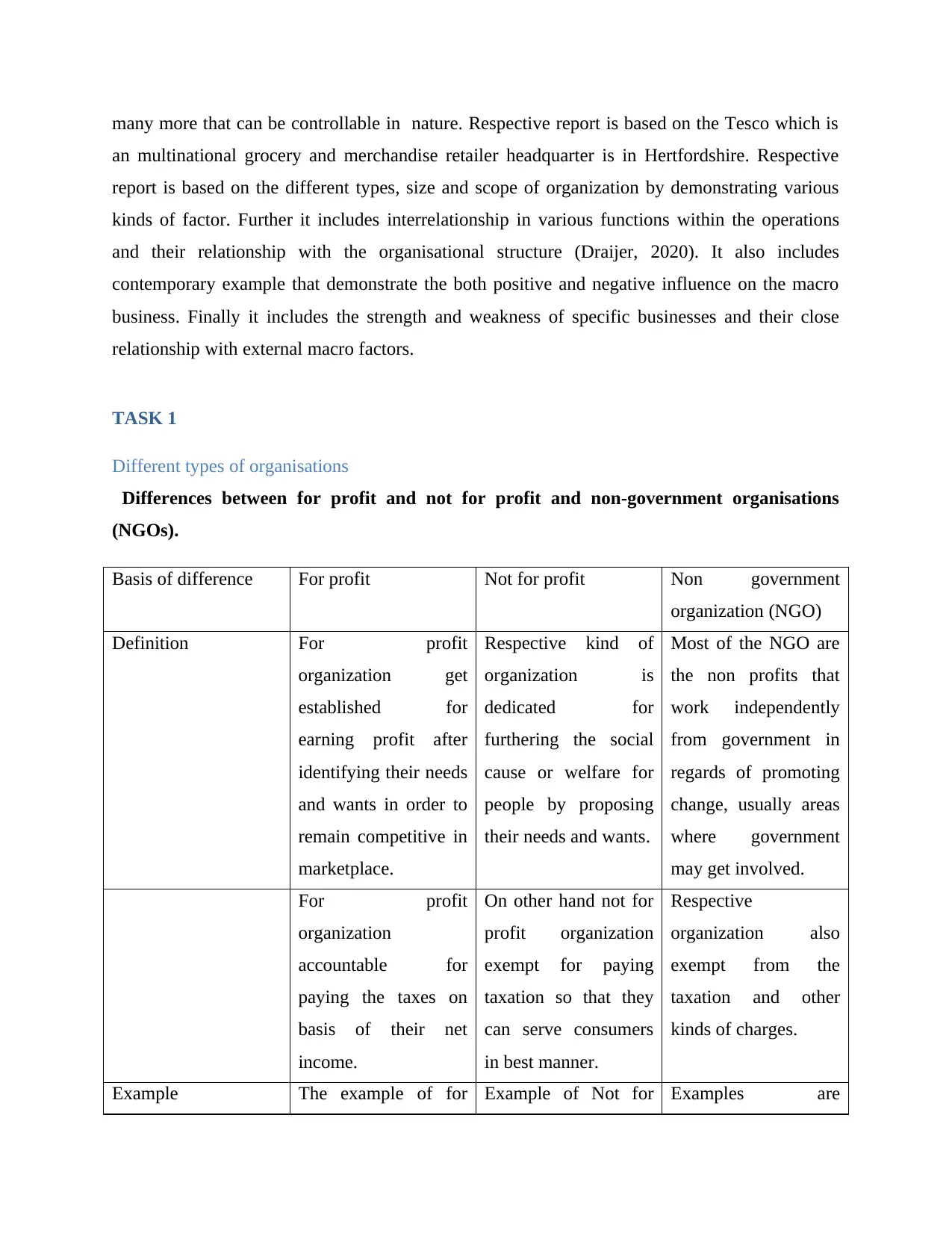
many more that can be controllable in nature. Respective report is based on the Tesco which is
an multinational grocery and merchandise retailer headquarter is in Hertfordshire. Respective
report is based on the different types, size and scope of organization by demonstrating various
kinds of factor. Further it includes interrelationship in various functions within the operations
and their relationship with the organisational structure (Draijer, 2020). It also includes
contemporary example that demonstrate the both positive and negative influence on the macro
business. Finally it includes the strength and weakness of specific businesses and their close
relationship with external macro factors.
TASK 1
Different types of organisations
Differences between for profit and not for profit and non-government organisations
(NGOs).
Basis of difference For profit Not for profit Non government
organization (NGO)
Definition For profit
organization get
established for
earning profit after
identifying their needs
and wants in order to
remain competitive in
marketplace.
Respective kind of
organization is
dedicated for
furthering the social
cause or welfare for
people by proposing
their needs and wants.
Most of the NGO are
the non profits that
work independently
from government in
regards of promoting
change, usually areas
where government
may get involved.
For profit
organization
accountable for
paying the taxes on
basis of their net
income.
On other hand not for
profit organization
exempt for paying
taxation so that they
can serve consumers
in best manner.
Respective
organization also
exempt from the
taxation and other
kinds of charges.
Example The example of for Example of Not for Examples are
an multinational grocery and merchandise retailer headquarter is in Hertfordshire. Respective
report is based on the different types, size and scope of organization by demonstrating various
kinds of factor. Further it includes interrelationship in various functions within the operations
and their relationship with the organisational structure (Draijer, 2020). It also includes
contemporary example that demonstrate the both positive and negative influence on the macro
business. Finally it includes the strength and weakness of specific businesses and their close
relationship with external macro factors.
TASK 1
Different types of organisations
Differences between for profit and not for profit and non-government organisations
(NGOs).
Basis of difference For profit Not for profit Non government
organization (NGO)
Definition For profit
organization get
established for
earning profit after
identifying their needs
and wants in order to
remain competitive in
marketplace.
Respective kind of
organization is
dedicated for
furthering the social
cause or welfare for
people by proposing
their needs and wants.
Most of the NGO are
the non profits that
work independently
from government in
regards of promoting
change, usually areas
where government
may get involved.
For profit
organization
accountable for
paying the taxes on
basis of their net
income.
On other hand not for
profit organization
exempt for paying
taxation so that they
can serve consumers
in best manner.
Respective
organization also
exempt from the
taxation and other
kinds of charges.
Example The example of for Example of Not for Examples are
Paraphrase This Document
Need a fresh take? Get an instant paraphrase of this document with our AI Paraphraser
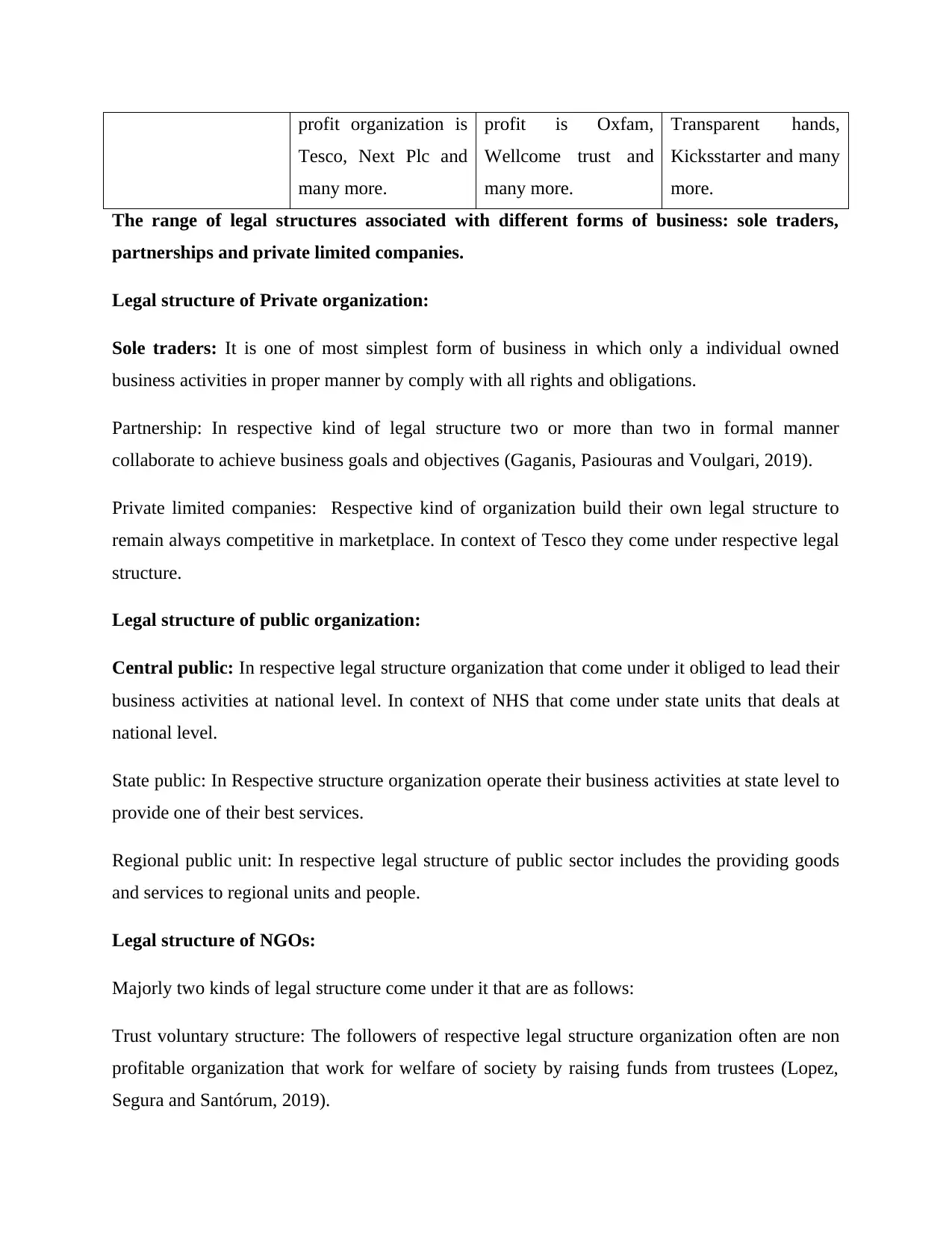
profit organization is
Tesco, Next Plc and
many more.
profit is Oxfam,
Wellcome trust and
many more.
Transparent hands,
Kicksstarter and many
more.
The range of legal structures associated with different forms of business: sole traders,
partnerships and private limited companies.
Legal structure of Private organization:
Sole traders: It is one of most simplest form of business in which only a individual owned
business activities in proper manner by comply with all rights and obligations.
Partnership: In respective kind of legal structure two or more than two in formal manner
collaborate to achieve business goals and objectives (Gaganis, Pasiouras and Voulgari, 2019).
Private limited companies: Respective kind of organization build their own legal structure to
remain always competitive in marketplace. In context of Tesco they come under respective legal
structure.
Legal structure of public organization:
Central public: In respective legal structure organization that come under it obliged to lead their
business activities at national level. In context of NHS that come under state units that deals at
national level.
State public: In Respective structure organization operate their business activities at state level to
provide one of their best services.
Regional public unit: In respective legal structure of public sector includes the providing goods
and services to regional units and people.
Legal structure of NGOs:
Majorly two kinds of legal structure come under it that are as follows:
Trust voluntary structure: The followers of respective legal structure organization often are non
profitable organization that work for welfare of society by raising funds from trustees (Lopez,
Segura and Santórum, 2019).
Tesco, Next Plc and
many more.
profit is Oxfam,
Wellcome trust and
many more.
Transparent hands,
Kicksstarter and many
more.
The range of legal structures associated with different forms of business: sole traders,
partnerships and private limited companies.
Legal structure of Private organization:
Sole traders: It is one of most simplest form of business in which only a individual owned
business activities in proper manner by comply with all rights and obligations.
Partnership: In respective kind of legal structure two or more than two in formal manner
collaborate to achieve business goals and objectives (Gaganis, Pasiouras and Voulgari, 2019).
Private limited companies: Respective kind of organization build their own legal structure to
remain always competitive in marketplace. In context of Tesco they come under respective legal
structure.
Legal structure of public organization:
Central public: In respective legal structure organization that come under it obliged to lead their
business activities at national level. In context of NHS that come under state units that deals at
national level.
State public: In Respective structure organization operate their business activities at state level to
provide one of their best services.
Regional public unit: In respective legal structure of public sector includes the providing goods
and services to regional units and people.
Legal structure of NGOs:
Majorly two kinds of legal structure come under it that are as follows:
Trust voluntary structure: The followers of respective legal structure organization often are non
profitable organization that work for welfare of society by raising funds from trustees (Lopez,
Segura and Santórum, 2019).
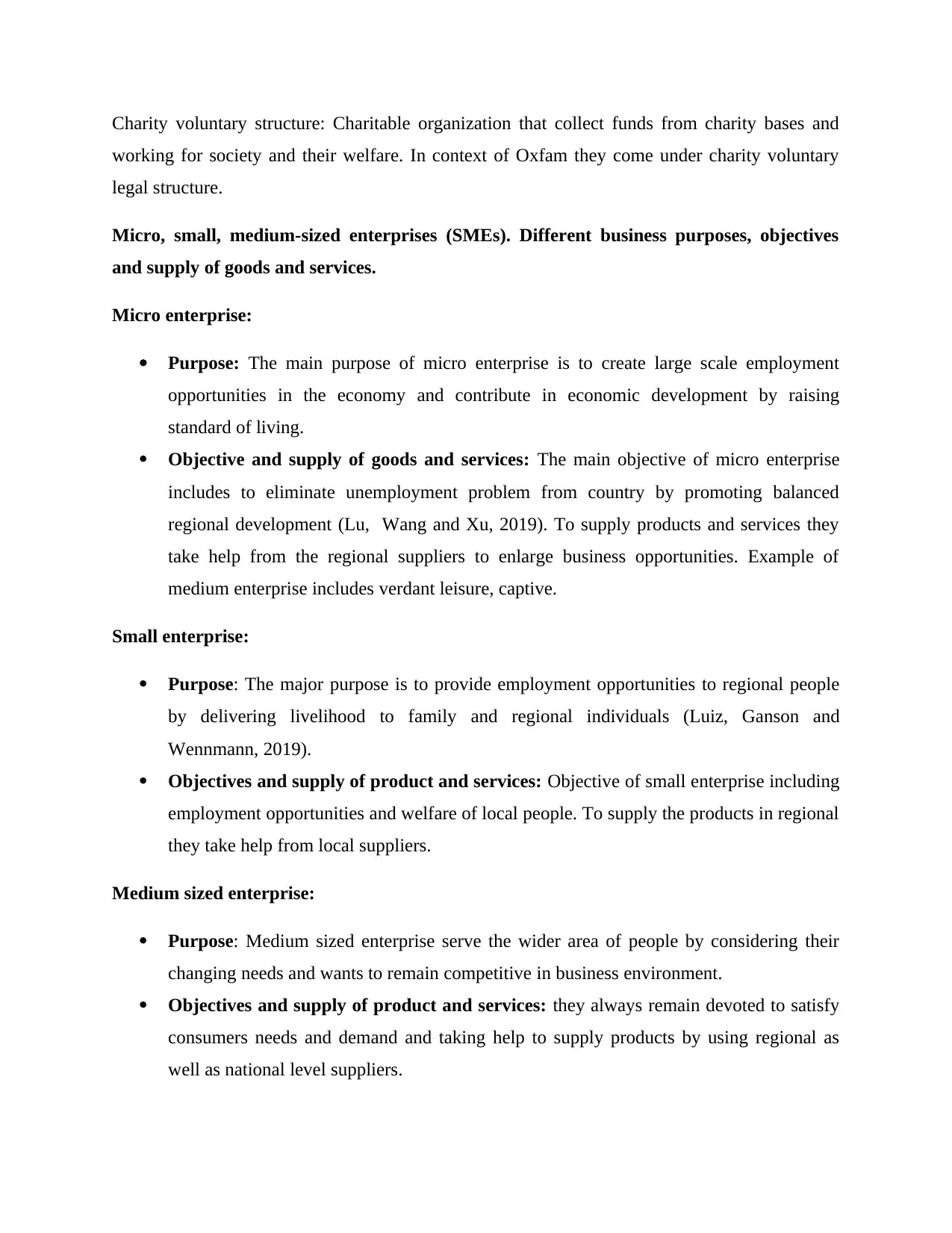
Charity voluntary structure: Charitable organization that collect funds from charity bases and
working for society and their welfare. In context of Oxfam they come under charity voluntary
legal structure.
Micro, small, medium-sized enterprises (SMEs). Different business purposes, objectives
and supply of goods and services.
Micro enterprise:
Purpose: The main purpose of micro enterprise is to create large scale employment
opportunities in the economy and contribute in economic development by raising
standard of living.
Objective and supply of goods and services: The main objective of micro enterprise
includes to eliminate unemployment problem from country by promoting balanced
regional development (Lu, Wang and Xu, 2019). To supply products and services they
take help from the regional suppliers to enlarge business opportunities. Example of
medium enterprise includes verdant leisure, captive.
Small enterprise:
Purpose: The major purpose is to provide employment opportunities to regional people
by delivering livelihood to family and regional individuals (Luiz, Ganson and
Wennmann, 2019).
Objectives and supply of product and services: Objective of small enterprise including
employment opportunities and welfare of local people. To supply the products in regional
they take help from local suppliers.
Medium sized enterprise:
Purpose: Medium sized enterprise serve the wider area of people by considering their
changing needs and wants to remain competitive in business environment.
Objectives and supply of product and services: they always remain devoted to satisfy
consumers needs and demand and taking help to supply products by using regional as
well as national level suppliers.
working for society and their welfare. In context of Oxfam they come under charity voluntary
legal structure.
Micro, small, medium-sized enterprises (SMEs). Different business purposes, objectives
and supply of goods and services.
Micro enterprise:
Purpose: The main purpose of micro enterprise is to create large scale employment
opportunities in the economy and contribute in economic development by raising
standard of living.
Objective and supply of goods and services: The main objective of micro enterprise
includes to eliminate unemployment problem from country by promoting balanced
regional development (Lu, Wang and Xu, 2019). To supply products and services they
take help from the regional suppliers to enlarge business opportunities. Example of
medium enterprise includes verdant leisure, captive.
Small enterprise:
Purpose: The major purpose is to provide employment opportunities to regional people
by delivering livelihood to family and regional individuals (Luiz, Ganson and
Wennmann, 2019).
Objectives and supply of product and services: Objective of small enterprise including
employment opportunities and welfare of local people. To supply the products in regional
they take help from local suppliers.
Medium sized enterprise:
Purpose: Medium sized enterprise serve the wider area of people by considering their
changing needs and wants to remain competitive in business environment.
Objectives and supply of product and services: they always remain devoted to satisfy
consumers needs and demand and taking help to supply products by using regional as
well as national level suppliers.
⊘ This is a preview!⊘
Do you want full access?
Subscribe today to unlock all pages.

Trusted by 1+ million students worldwide
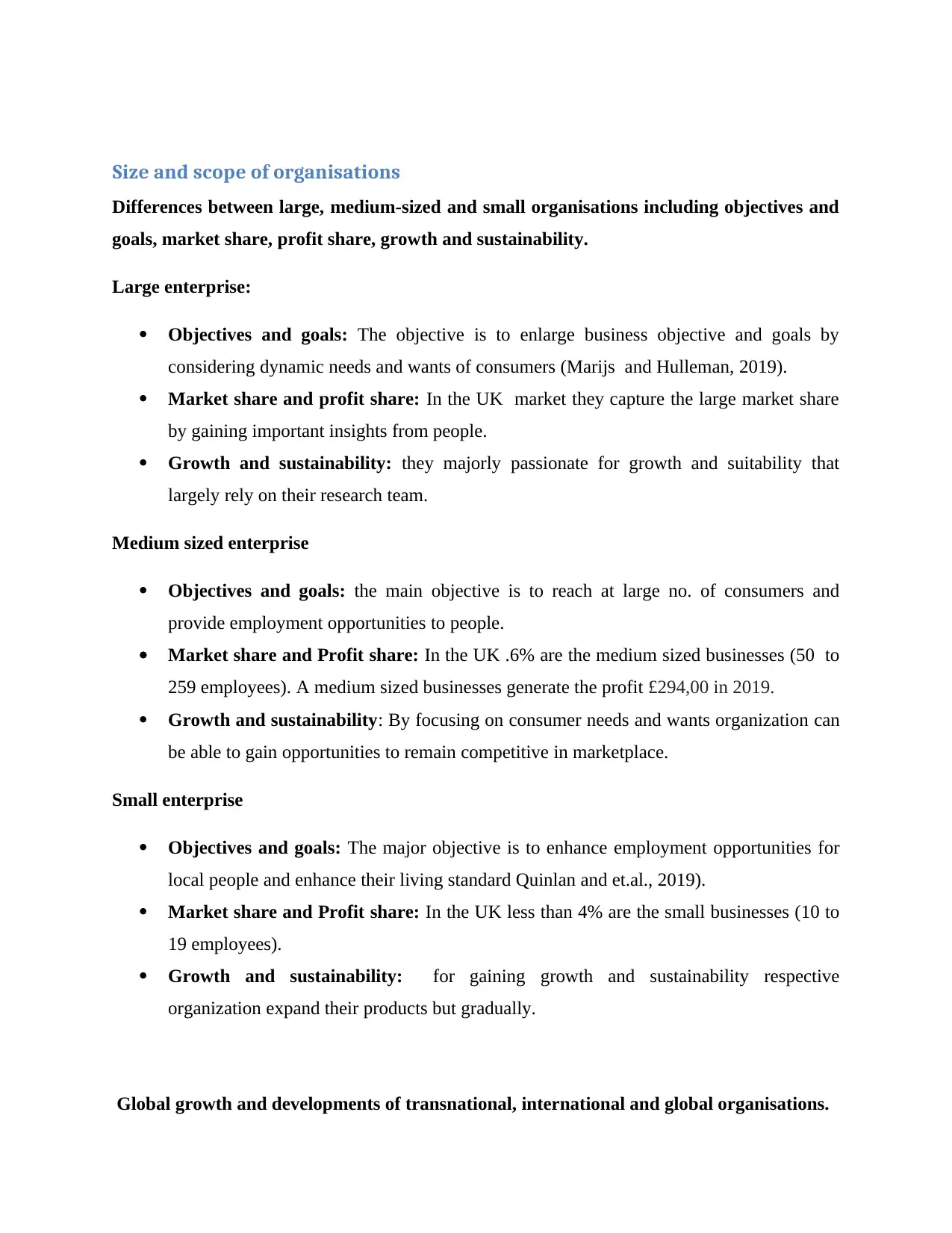
Size and scope of organisations
Differences between large, medium-sized and small organisations including objectives and
goals, market share, profit share, growth and sustainability.
Large enterprise:
Objectives and goals: The objective is to enlarge business objective and goals by
considering dynamic needs and wants of consumers (Marijs and Hulleman, 2019).
Market share and profit share: In the UK market they capture the large market share
by gaining important insights from people.
Growth and sustainability: they majorly passionate for growth and suitability that
largely rely on their research team.
Medium sized enterprise
Objectives and goals: the main objective is to reach at large no. of consumers and
provide employment opportunities to people.
Market share and Profit share: In the UK .6% are the medium sized businesses (50 to
259 employees). A medium sized businesses generate the profit £294,00 in 2019.
Growth and sustainability: By focusing on consumer needs and wants organization can
be able to gain opportunities to remain competitive in marketplace.
Small enterprise
Objectives and goals: The major objective is to enhance employment opportunities for
local people and enhance their living standard Quinlan and et.al., 2019).
Market share and Profit share: In the UK less than 4% are the small businesses (10 to
19 employees).
Growth and sustainability: for gaining growth and sustainability respective
organization expand their products but gradually.
Global growth and developments of transnational, international and global organisations.
Differences between large, medium-sized and small organisations including objectives and
goals, market share, profit share, growth and sustainability.
Large enterprise:
Objectives and goals: The objective is to enlarge business objective and goals by
considering dynamic needs and wants of consumers (Marijs and Hulleman, 2019).
Market share and profit share: In the UK market they capture the large market share
by gaining important insights from people.
Growth and sustainability: they majorly passionate for growth and suitability that
largely rely on their research team.
Medium sized enterprise
Objectives and goals: the main objective is to reach at large no. of consumers and
provide employment opportunities to people.
Market share and Profit share: In the UK .6% are the medium sized businesses (50 to
259 employees). A medium sized businesses generate the profit £294,00 in 2019.
Growth and sustainability: By focusing on consumer needs and wants organization can
be able to gain opportunities to remain competitive in marketplace.
Small enterprise
Objectives and goals: The major objective is to enhance employment opportunities for
local people and enhance their living standard Quinlan and et.al., 2019).
Market share and Profit share: In the UK less than 4% are the small businesses (10 to
19 employees).
Growth and sustainability: for gaining growth and sustainability respective
organization expand their products but gradually.
Global growth and developments of transnational, international and global organisations.
Paraphrase This Document
Need a fresh take? Get an instant paraphrase of this document with our AI Paraphraser
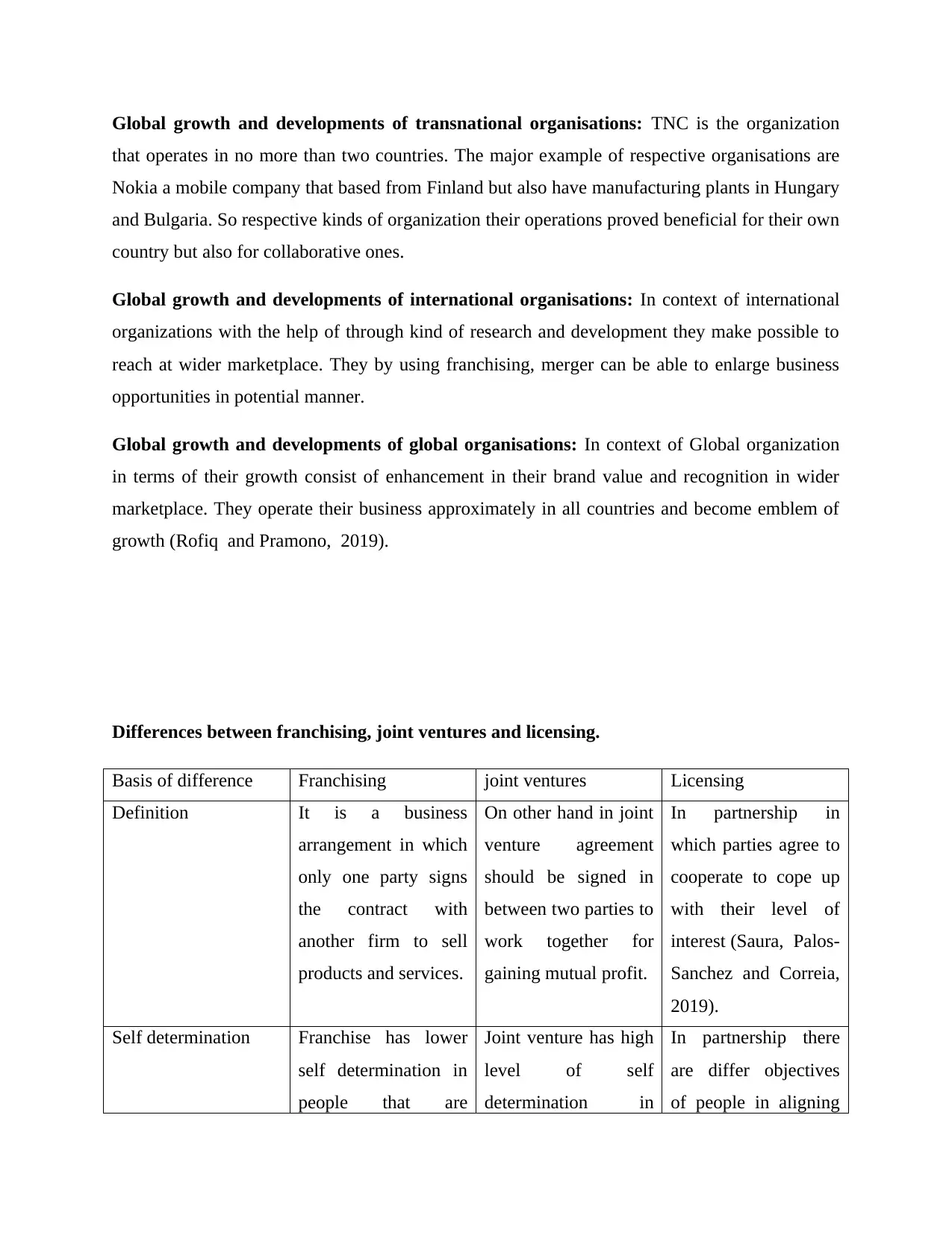
Global growth and developments of transnational organisations: TNC is the organization
that operates in no more than two countries. The major example of respective organisations are
Nokia a mobile company that based from Finland but also have manufacturing plants in Hungary
and Bulgaria. So respective kinds of organization their operations proved beneficial for their own
country but also for collaborative ones.
Global growth and developments of international organisations: In context of international
organizations with the help of through kind of research and development they make possible to
reach at wider marketplace. They by using franchising, merger can be able to enlarge business
opportunities in potential manner.
Global growth and developments of global organisations: In context of Global organization
in terms of their growth consist of enhancement in their brand value and recognition in wider
marketplace. They operate their business approximately in all countries and become emblem of
growth (Rofiq and Pramono, 2019).
Differences between franchising, joint ventures and licensing.
Basis of difference Franchising joint ventures Licensing
Definition It is a business
arrangement in which
only one party signs
the contract with
another firm to sell
products and services.
On other hand in joint
venture agreement
should be signed in
between two parties to
work together for
gaining mutual profit.
In partnership in
which parties agree to
cooperate to cope up
with their level of
interest (Saura, Palos-
Sanchez and Correia,
2019).
Self determination Franchise has lower
self determination in
people that are
Joint venture has high
level of self
determination in
In partnership there
are differ objectives
of people in aligning
that operates in no more than two countries. The major example of respective organisations are
Nokia a mobile company that based from Finland but also have manufacturing plants in Hungary
and Bulgaria. So respective kinds of organization their operations proved beneficial for their own
country but also for collaborative ones.
Global growth and developments of international organisations: In context of international
organizations with the help of through kind of research and development they make possible to
reach at wider marketplace. They by using franchising, merger can be able to enlarge business
opportunities in potential manner.
Global growth and developments of global organisations: In context of Global organization
in terms of their growth consist of enhancement in their brand value and recognition in wider
marketplace. They operate their business approximately in all countries and become emblem of
growth (Rofiq and Pramono, 2019).
Differences between franchising, joint ventures and licensing.
Basis of difference Franchising joint ventures Licensing
Definition It is a business
arrangement in which
only one party signs
the contract with
another firm to sell
products and services.
On other hand in joint
venture agreement
should be signed in
between two parties to
work together for
gaining mutual profit.
In partnership in
which parties agree to
cooperate to cope up
with their level of
interest (Saura, Palos-
Sanchez and Correia,
2019).
Self determination Franchise has lower
self determination in
people that are
Joint venture has high
level of self
determination in
In partnership there
are differ objectives
of people in aligning
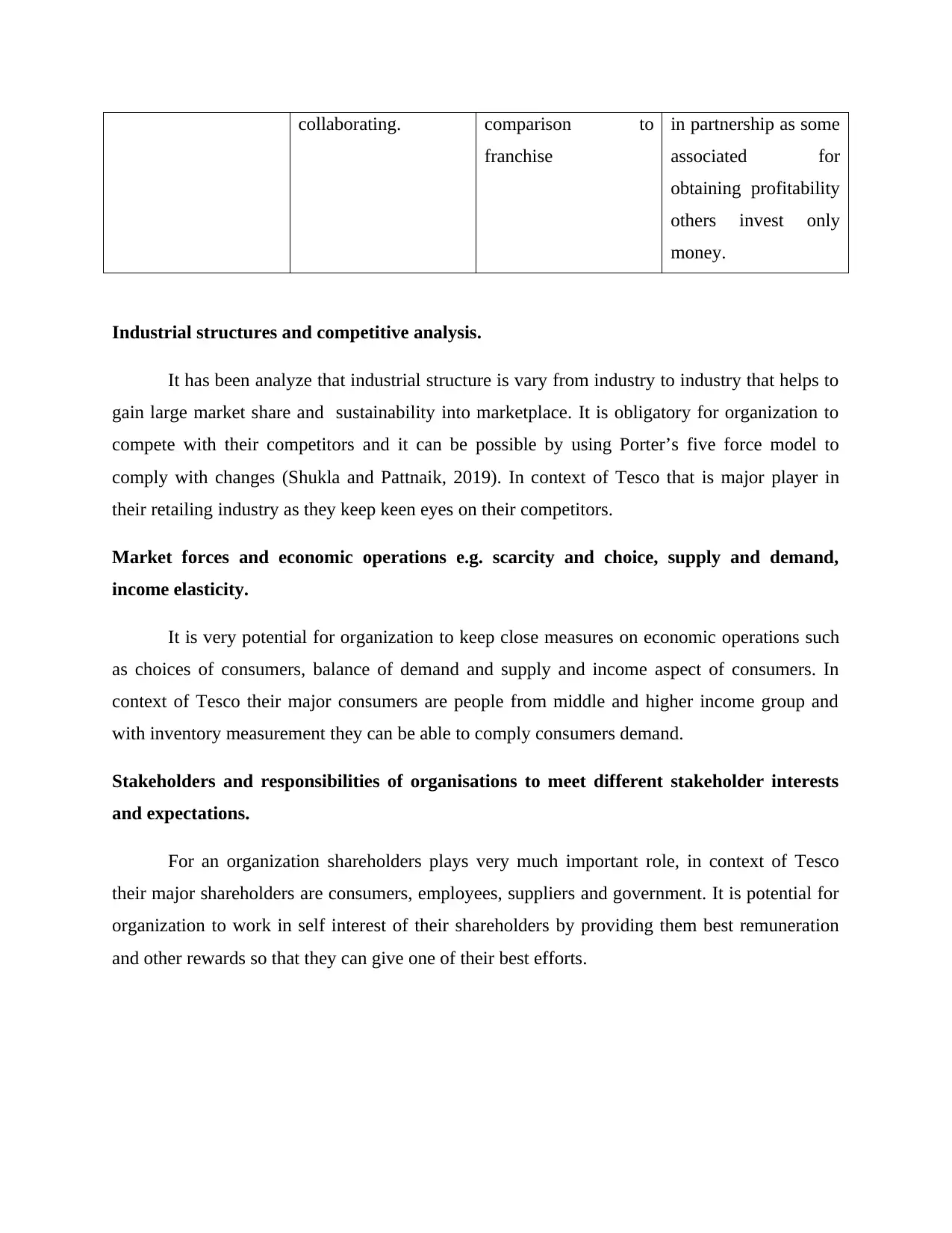
collaborating. comparison to
franchise
in partnership as some
associated for
obtaining profitability
others invest only
money.
Industrial structures and competitive analysis.
It has been analyze that industrial structure is vary from industry to industry that helps to
gain large market share and sustainability into marketplace. It is obligatory for organization to
compete with their competitors and it can be possible by using Porter’s five force model to
comply with changes (Shukla and Pattnaik, 2019). In context of Tesco that is major player in
their retailing industry as they keep keen eyes on their competitors.
Market forces and economic operations e.g. scarcity and choice, supply and demand,
income elasticity.
It is very potential for organization to keep close measures on economic operations such
as choices of consumers, balance of demand and supply and income aspect of consumers. In
context of Tesco their major consumers are people from middle and higher income group and
with inventory measurement they can be able to comply consumers demand.
Stakeholders and responsibilities of organisations to meet different stakeholder interests
and expectations.
For an organization shareholders plays very much important role, in context of Tesco
their major shareholders are consumers, employees, suppliers and government. It is potential for
organization to work in self interest of their shareholders by providing them best remuneration
and other rewards so that they can give one of their best efforts.
franchise
in partnership as some
associated for
obtaining profitability
others invest only
money.
Industrial structures and competitive analysis.
It has been analyze that industrial structure is vary from industry to industry that helps to
gain large market share and sustainability into marketplace. It is obligatory for organization to
compete with their competitors and it can be possible by using Porter’s five force model to
comply with changes (Shukla and Pattnaik, 2019). In context of Tesco that is major player in
their retailing industry as they keep keen eyes on their competitors.
Market forces and economic operations e.g. scarcity and choice, supply and demand,
income elasticity.
It is very potential for organization to keep close measures on economic operations such
as choices of consumers, balance of demand and supply and income aspect of consumers. In
context of Tesco their major consumers are people from middle and higher income group and
with inventory measurement they can be able to comply consumers demand.
Stakeholders and responsibilities of organisations to meet different stakeholder interests
and expectations.
For an organization shareholders plays very much important role, in context of Tesco
their major shareholders are consumers, employees, suppliers and government. It is potential for
organization to work in self interest of their shareholders by providing them best remuneration
and other rewards so that they can give one of their best efforts.
⊘ This is a preview!⊘
Do you want full access?
Subscribe today to unlock all pages.

Trusted by 1+ million students worldwide
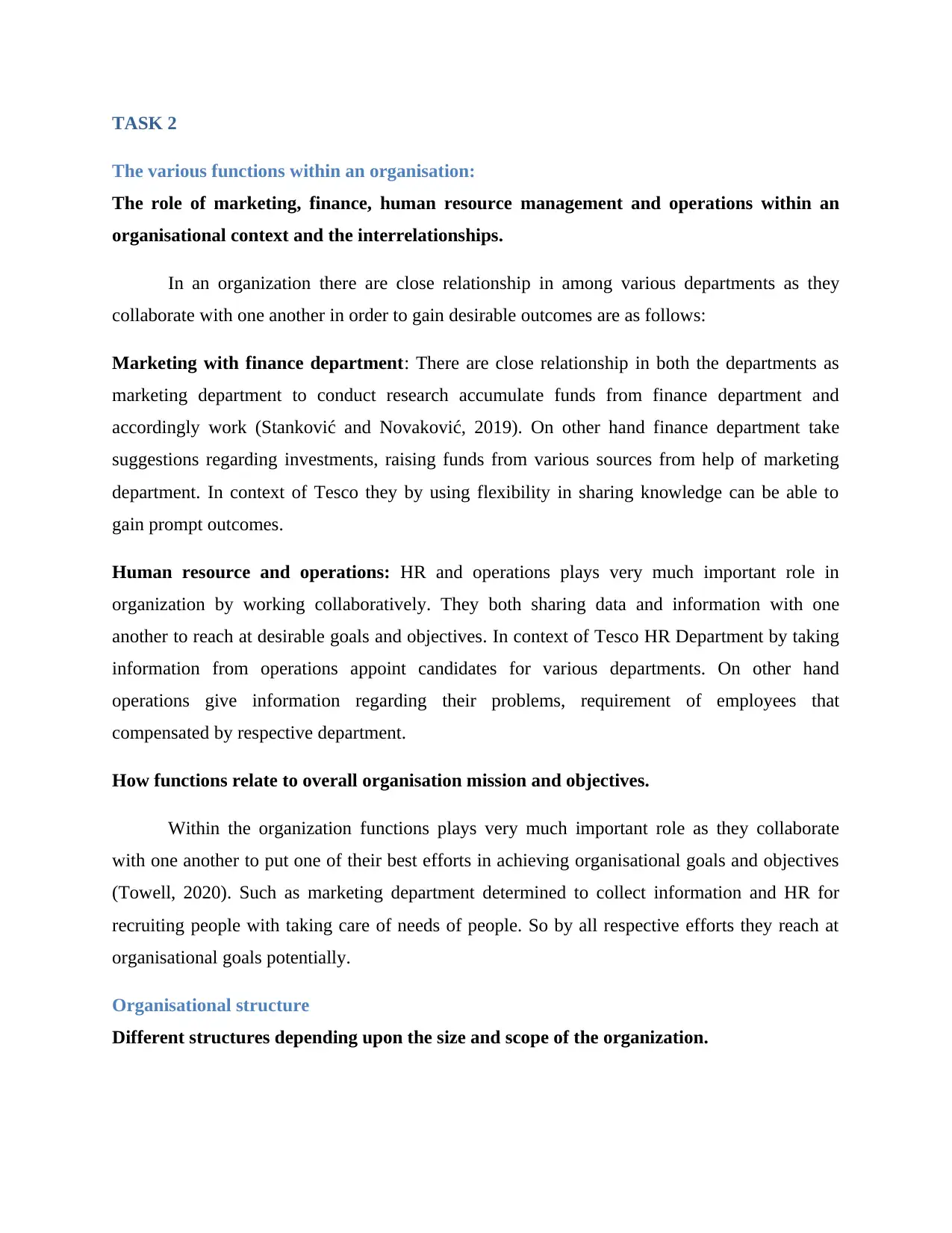
TASK 2
The various functions within an organisation:
The role of marketing, finance, human resource management and operations within an
organisational context and the interrelationships.
In an organization there are close relationship in among various departments as they
collaborate with one another in order to gain desirable outcomes are as follows:
Marketing with finance department: There are close relationship in both the departments as
marketing department to conduct research accumulate funds from finance department and
accordingly work (Stanković and Novaković, 2019). On other hand finance department take
suggestions regarding investments, raising funds from various sources from help of marketing
department. In context of Tesco they by using flexibility in sharing knowledge can be able to
gain prompt outcomes.
Human resource and operations: HR and operations plays very much important role in
organization by working collaboratively. They both sharing data and information with one
another to reach at desirable goals and objectives. In context of Tesco HR Department by taking
information from operations appoint candidates for various departments. On other hand
operations give information regarding their problems, requirement of employees that
compensated by respective department.
How functions relate to overall organisation mission and objectives.
Within the organization functions plays very much important role as they collaborate
with one another to put one of their best efforts in achieving organisational goals and objectives
(Towell, 2020). Such as marketing department determined to collect information and HR for
recruiting people with taking care of needs of people. So by all respective efforts they reach at
organisational goals potentially.
Organisational structure
Different structures depending upon the size and scope of the organization.
The various functions within an organisation:
The role of marketing, finance, human resource management and operations within an
organisational context and the interrelationships.
In an organization there are close relationship in among various departments as they
collaborate with one another in order to gain desirable outcomes are as follows:
Marketing with finance department: There are close relationship in both the departments as
marketing department to conduct research accumulate funds from finance department and
accordingly work (Stanković and Novaković, 2019). On other hand finance department take
suggestions regarding investments, raising funds from various sources from help of marketing
department. In context of Tesco they by using flexibility in sharing knowledge can be able to
gain prompt outcomes.
Human resource and operations: HR and operations plays very much important role in
organization by working collaboratively. They both sharing data and information with one
another to reach at desirable goals and objectives. In context of Tesco HR Department by taking
information from operations appoint candidates for various departments. On other hand
operations give information regarding their problems, requirement of employees that
compensated by respective department.
How functions relate to overall organisation mission and objectives.
Within the organization functions plays very much important role as they collaborate
with one another to put one of their best efforts in achieving organisational goals and objectives
(Towell, 2020). Such as marketing department determined to collect information and HR for
recruiting people with taking care of needs of people. So by all respective efforts they reach at
organisational goals potentially.
Organisational structure
Different structures depending upon the size and scope of the organization.
Paraphrase This Document
Need a fresh take? Get an instant paraphrase of this document with our AI Paraphraser
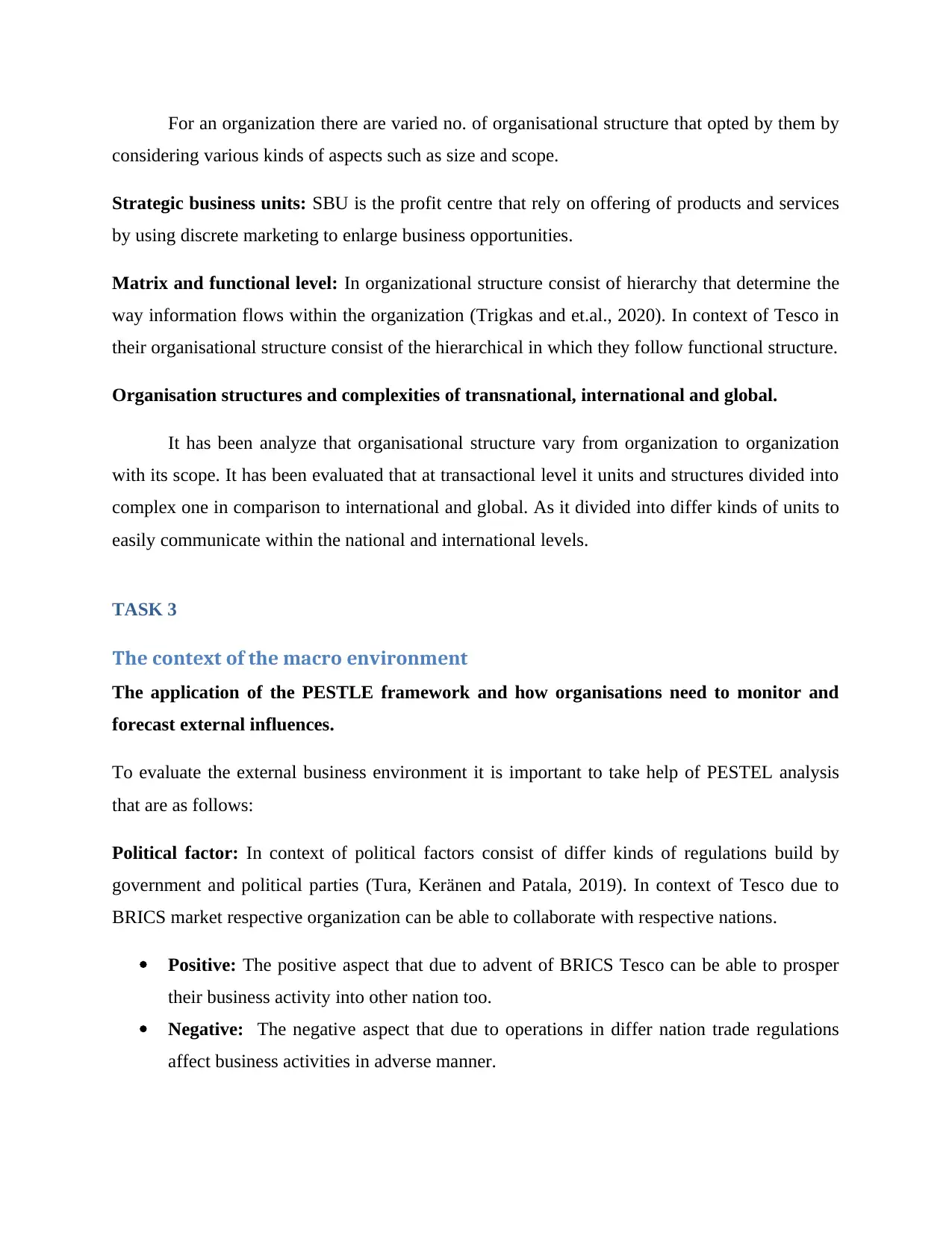
For an organization there are varied no. of organisational structure that opted by them by
considering various kinds of aspects such as size and scope.
Strategic business units: SBU is the profit centre that rely on offering of products and services
by using discrete marketing to enlarge business opportunities.
Matrix and functional level: In organizational structure consist of hierarchy that determine the
way information flows within the organization (Trigkas and et.al., 2020). In context of Tesco in
their organisational structure consist of the hierarchical in which they follow functional structure.
Organisation structures and complexities of transnational, international and global.
It has been analyze that organisational structure vary from organization to organization
with its scope. It has been evaluated that at transactional level it units and structures divided into
complex one in comparison to international and global. As it divided into differ kinds of units to
easily communicate within the national and international levels.
TASK 3
The context of the macro environment
The application of the PESTLE framework and how organisations need to monitor and
forecast external influences.
To evaluate the external business environment it is important to take help of PESTEL analysis
that are as follows:
Political factor: In context of political factors consist of differ kinds of regulations build by
government and political parties (Tura, Keränen and Patala, 2019). In context of Tesco due to
BRICS market respective organization can be able to collaborate with respective nations.
Positive: The positive aspect that due to advent of BRICS Tesco can be able to prosper
their business activity into other nation too.
Negative: The negative aspect that due to operations in differ nation trade regulations
affect business activities in adverse manner.
considering various kinds of aspects such as size and scope.
Strategic business units: SBU is the profit centre that rely on offering of products and services
by using discrete marketing to enlarge business opportunities.
Matrix and functional level: In organizational structure consist of hierarchy that determine the
way information flows within the organization (Trigkas and et.al., 2020). In context of Tesco in
their organisational structure consist of the hierarchical in which they follow functional structure.
Organisation structures and complexities of transnational, international and global.
It has been analyze that organisational structure vary from organization to organization
with its scope. It has been evaluated that at transactional level it units and structures divided into
complex one in comparison to international and global. As it divided into differ kinds of units to
easily communicate within the national and international levels.
TASK 3
The context of the macro environment
The application of the PESTLE framework and how organisations need to monitor and
forecast external influences.
To evaluate the external business environment it is important to take help of PESTEL analysis
that are as follows:
Political factor: In context of political factors consist of differ kinds of regulations build by
government and political parties (Tura, Keränen and Patala, 2019). In context of Tesco due to
BRICS market respective organization can be able to collaborate with respective nations.
Positive: The positive aspect that due to advent of BRICS Tesco can be able to prosper
their business activity into other nation too.
Negative: The negative aspect that due to operations in differ nation trade regulations
affect business activities in adverse manner.
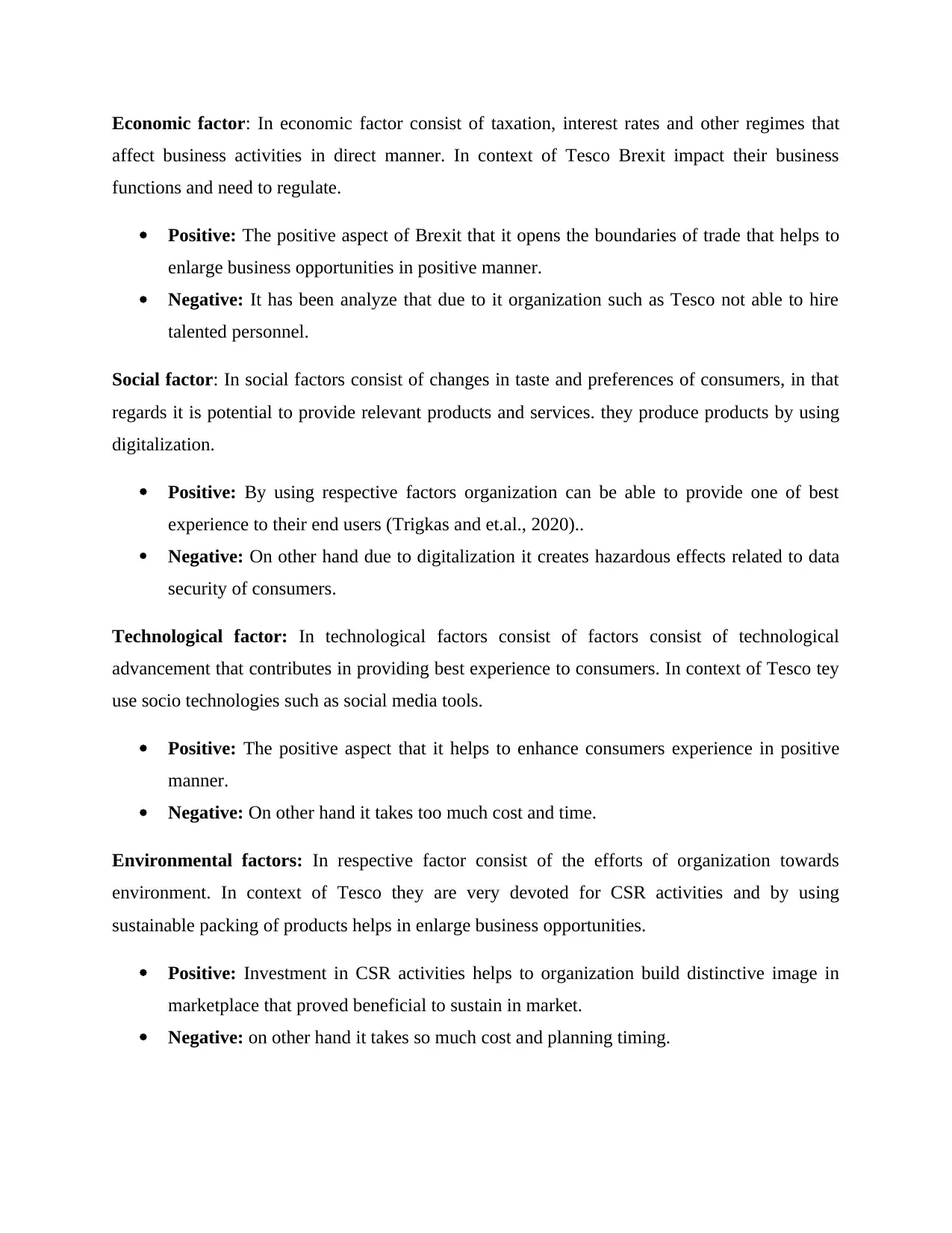
Economic factor: In economic factor consist of taxation, interest rates and other regimes that
affect business activities in direct manner. In context of Tesco Brexit impact their business
functions and need to regulate.
Positive: The positive aspect of Brexit that it opens the boundaries of trade that helps to
enlarge business opportunities in positive manner.
Negative: It has been analyze that due to it organization such as Tesco not able to hire
talented personnel.
Social factor: In social factors consist of changes in taste and preferences of consumers, in that
regards it is potential to provide relevant products and services. they produce products by using
digitalization.
Positive: By using respective factors organization can be able to provide one of best
experience to their end users (Trigkas and et.al., 2020)..
Negative: On other hand due to digitalization it creates hazardous effects related to data
security of consumers.
Technological factor: In technological factors consist of factors consist of technological
advancement that contributes in providing best experience to consumers. In context of Tesco tey
use socio technologies such as social media tools.
Positive: The positive aspect that it helps to enhance consumers experience in positive
manner.
Negative: On other hand it takes too much cost and time.
Environmental factors: In respective factor consist of the efforts of organization towards
environment. In context of Tesco they are very devoted for CSR activities and by using
sustainable packing of products helps in enlarge business opportunities.
Positive: Investment in CSR activities helps to organization build distinctive image in
marketplace that proved beneficial to sustain in market.
Negative: on other hand it takes so much cost and planning timing.
affect business activities in direct manner. In context of Tesco Brexit impact their business
functions and need to regulate.
Positive: The positive aspect of Brexit that it opens the boundaries of trade that helps to
enlarge business opportunities in positive manner.
Negative: It has been analyze that due to it organization such as Tesco not able to hire
talented personnel.
Social factor: In social factors consist of changes in taste and preferences of consumers, in that
regards it is potential to provide relevant products and services. they produce products by using
digitalization.
Positive: By using respective factors organization can be able to provide one of best
experience to their end users (Trigkas and et.al., 2020)..
Negative: On other hand due to digitalization it creates hazardous effects related to data
security of consumers.
Technological factor: In technological factors consist of factors consist of technological
advancement that contributes in providing best experience to consumers. In context of Tesco tey
use socio technologies such as social media tools.
Positive: The positive aspect that it helps to enhance consumers experience in positive
manner.
Negative: On other hand it takes too much cost and time.
Environmental factors: In respective factor consist of the efforts of organization towards
environment. In context of Tesco they are very devoted for CSR activities and by using
sustainable packing of products helps in enlarge business opportunities.
Positive: Investment in CSR activities helps to organization build distinctive image in
marketplace that proved beneficial to sustain in market.
Negative: on other hand it takes so much cost and planning timing.
⊘ This is a preview!⊘
Do you want full access?
Subscribe today to unlock all pages.

Trusted by 1+ million students worldwide
1 out of 18
Related Documents
Your All-in-One AI-Powered Toolkit for Academic Success.
+13062052269
info@desklib.com
Available 24*7 on WhatsApp / Email
![[object Object]](/_next/static/media/star-bottom.7253800d.svg)
Unlock your academic potential
Copyright © 2020–2025 A2Z Services. All Rights Reserved. Developed and managed by ZUCOL.



